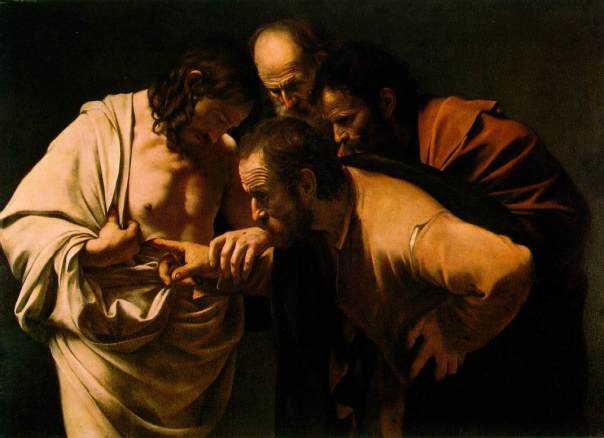The Incredulity of Saint Thomas, by Caravaggio, was made in 1602 with oil paint on canvas.
As with many of Caravaggio’s paintings, he uses some of the most well-know biblical scenes as painting subjects. In this painting, what is depicted is Jesus, having just risen from the dead, visiting his apostles and proclaiming to them that he is risen by the power of, and his faith in, God. Saint Thomas, and what appears to be Saint Peter and one other saint, have hidden in a house, doors locked so they aren’t discovered and crucified like Jesus. And when Jesus appears before them Saint Peter thinks he is a ghost, not a living man. He doesn’t believe Jesus when he tells Thomas he is flesh and blood, so Jesus guides his hand to his spear wound on his ribs. After putting his hand in his wound does Thomas believe and ask for forgiveness from Christ.
That’s how the story goes anyway.
But I didn’t really pick this painting out for its story; this same scene has been painted and draw many times. I picked this one because of the interpretation and the composition.
Caravaggio, as with many of his other works, likes to use primary colors, (as you can verify below). Color doesn’t seem that important to him, (a true Poussinist, if you will). He concentrates more on the line, light, and shadow of the characters, giving them true depth, not only to our eye, but to our mind as well. He also uses the diamond of heads in the top, middle of the painting as a starting point for our eyes to follow, from the shining baldness, down Christ’s body, and back up again, lingering over the wrinkles in the clothing and foreheads.
Now examine Christ’s body. See how bright it is, the light almost directly on him? And how his head/face is darkened? This seems to symbolize some of the moods of the time. First of all, Caravaggio was different from most artists in the previous eras in that he used Realism in a religious painting. He made christ appear just as human as the other two, (but indicated that he wasn’t through simple painting techniques). The only thing different from Christ and the other men is that he is slightly less clothed, (and not bald). While that may be, he is more so than Renaissance art would have done him, (just a man-thong, usually). This brings to mind the Council of Trent; they would’ve had much influence on art in the Baroque era, above all being that this painting is a biblical reference! They would have commissioned many paintings like this, either through the church or for their own recreation.
But that isn’t all. The Council, which was battling a large threat to the Catholic religion, (Protestants!), needed to spread their influence, and at the same time make the church seem less cold. The best way to do this was ease off of the “punishment” part of the church and move to a more forgiving mind-set that would appeal to the people while still reminding them of the purpose of the church.
Caravaggio’s painting displays all of this: the Realism which would have really meant something to the common people, the emotion ebbing from Christ and the pain he’d endured. You can almost feel the wound yourself from looking at this painting. The way the skin is pulled away from the body, (that part makes me think of raw chicken, I can almost taste it! Blech!). And the guilt you feel after seeing the pain on Christ’s face. The surprise on Thomas’ reaction is understandable and makes you want to believe that the same would’ve happened to you in that situation.
This is one of Caravaggio’s best paintings and it is understandable why so many artists were influenced by him. The raw emotion permeating from this lifeless canvas board is outstanding. And not only is it a well composed piece, but it is skillfully painted and expresses the artist’s voice.



I really enjoyed reading your blogs! You go into a lot of detail and make me want to redo my entire blog lol I also enjoyed the peices you presented because like you stated they show a lot of emotion, I especially loved your comparison to raw chicken!
It is difficult to characterize Caravaggio’s work by line or color. It is more about value, which is a concern of color. Value is the amount of light and dark. Certainly Caravaggio manipulates light and dark to the extreme in all his works, giving high definition to portions of the painting, while leaving other parts in darkness and up to the imagination of the viewer.